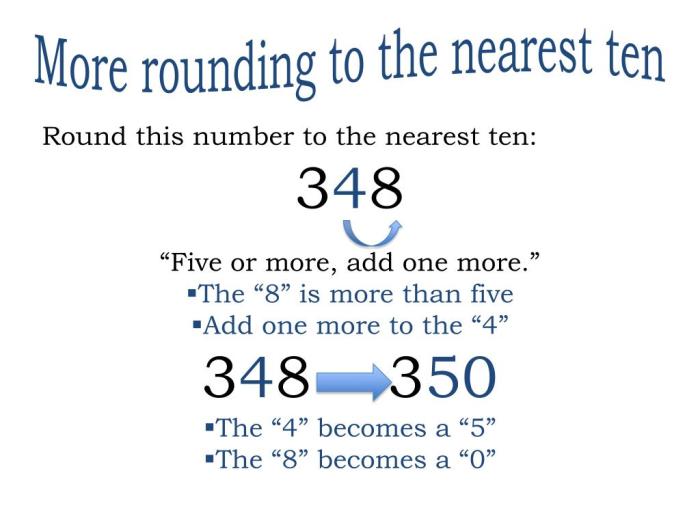Round 298 to the nearest ten? No problem! This comprehensive guide will take you through the concept of rounding numbers, its significance, and the specific steps involved in rounding 298 to the nearest ten. Get ready to simplify calculations and enhance your understanding of rounding techniques.
Rounding numbers is a fundamental mathematical operation that involves adjusting a number to a specific level of precision. When rounding to the nearest ten, we find the closest multiple of ten to the given number. This process is commonly used in everyday life, from rounding off financial figures to simplifying measurements and data analysis.
Rounding to the Nearest Ten: Round 298 To The Nearest Ten

Rounding numbers to the nearest ten is a mathematical technique that simplifies numerical values by replacing them with their closest multiples of ten. It involves identifying the digit in the tens place and adjusting the following digits accordingly.
Examples
For example, 25 rounded to the nearest ten becomes 30 (the closest multiple of ten greater than 25), while 78 rounded to the nearest ten becomes 80 (the closest multiple of ten greater than 78). Similarly, 123 rounded to the nearest ten becomes 120 (the closest multiple of ten less than 123).
Significance
Rounding numbers to the nearest ten has several significant applications in mathematical operations:
- It simplifies calculations by reducing the number of digits involved, making operations easier and less time-consuming.
- It provides a level of approximation that can be useful for estimating values or making rough calculations.
- It helps to identify trends or patterns in data by smoothing out minor fluctuations and highlighting the general direction of change.
Rounding 298 to the Nearest Ten

Given the number 298, we are tasked with rounding it to the nearest ten.
Steps for Rounding 298 to the Nearest Ten
To round 298 to the nearest ten, we follow these steps:
- Look at the digit in the tens place, which is 9 in this case.
- If the digit in the ones place is 5 or greater, we round up the tens digit by one. Since 8 is greater than 5, we round up the 9 to 10.
- If the digit in the ones place is less than 5, we leave the tens digit unchanged. In this case, it does not apply.
- Change all the digits to the right of the rounded digit to zero.
Rounded Result, Round 298 to the nearest ten
Following these steps, we round 298 to the nearest ten as follows:
rounded to the nearest ten is 300.
Applications of Rounding

Rounding is a valuable tool that simplifies calculations and improves readability in various practical applications.
Finance
In finance, rounding is used to simplify calculations and present data in a more manageable form. For example, stock prices are often rounded to the nearest dollar or cent to make them easier to read and compare.
Round 298 to the nearest ten is 300. If you’re curious about Act 3 of Arthur Miller’s “The Crucible,” check out this quiz . It’ll test your knowledge of the events that unfold in this pivotal act. Returning to our math problem, round 298 to the nearest ten is indeed 300.
Measurements
Rounding is also used in measurements to simplify calculations and improve accuracy. For example, when measuring the length of an object, it may be rounded to the nearest centimeter or millimeter to make the measurement more precise.
Data Analysis
In data analysis, rounding is used to summarize and simplify large datasets. For example, when analyzing sales data, the sales figures may be rounded to the nearest thousand or million to make the data more manageable and easier to interpret.
Alternative Rounding Methods

In addition to rounding to the nearest ten, there are other alternative rounding methods that can be used in different situations.
These methods include rounding up, rounding down, and rounding to a specific number of significant digits.
Rounding Up
Rounding up involves increasing the value of a number to the next highest whole number.
For example, if we round up 298 to the nearest ten, the result would be 300.
Rounding up is often used when it is important to avoid underestimating a value.
Rounding Down
Rounding down involves decreasing the value of a number to the next lowest whole number.
For example, if we round down 298 to the nearest ten, the result would be 290.
Rounding down is often used when it is important to avoid overestimating a value.
Rounding to a Specific Number of Significant Digits
Rounding to a specific number of significant digits involves keeping only the specified number of digits in a number, starting from the leftmost non-zero digit.
For example, if we round 298 to two significant digits, the result would be 300.
Rounding to a specific number of significant digits is often used when it is important to maintain a certain level of precision in a number.
Detailed FAQs
What is the concept of rounding numbers?
Rounding numbers involves adjusting a number to a specific level of precision, such as rounding to the nearest ten, hundred, or thousand.
Why is rounding significant in mathematical operations?
Rounding helps simplify calculations, improve readability, and reduce the impact of insignificant digits on the final result.
Are there alternative rounding methods besides rounding to the nearest ten?
Yes, other rounding methods include rounding up, rounding down, and rounding to a specific number of significant digits.